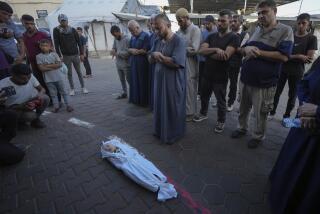6 Al Qaeda Holdouts Killed in Afghan Hospital Battle
- Share via
KANDAHAR, Afghanistan — After a dramatic 10-hour battle Monday, a combined force of Afghan government militiamen and U.S. Special Forces soldiers overwhelmed six Al Qaeda fighters who had been holed up in a wing of Kandahar’s biggest hospital since early December.
All six Arabs were killed in the operation, ending a standoff that had dragged on for so long that authorities had contemplated starvation, flooding and electrocution as ways to overcome the men.
“They [the holdouts] are all dead,” Kandahar government spokesman Khalid Pushtoon told reporters outside the hospital a few minutes after the small-arms fire had stopped. “They fought until the last drop of their blood.”
The raid began before dawn with an ultimatum to surrender and ended in the early afternoon with a 45-minute final assault that included percussion grenades, tear gas and a hail of small-arms fire.
Five Afghan militiamen were injured. One reportedly was shot in the head and was taken for treatment to a U.S. military base at the Kandahar airport about 10 miles south of the city. None of the Americans were hurt.
According to those involved in the battle, the assault force consisted of about 100 Afghan militiamen and 15 American Special Forces personnel.
“Americans are giving the instructions,” Afghan police officer Mohammed said in an interview outside the hospital grounds during a lull in the fighting. “Whatever they say, we do. It’s a joint operation.”
One Special Forces soldier wore a New York Yankees baseball cap, while another had an “I Love New York” button pinned to his headgear.
Monday’s battle was part of an arduous mopping-up operation to rid Afghanistan of the remaining pockets of Taliban and Al Qaeda forces still holding out in parts of southern Afghanistan. The operations are usually conducted with little publicity, but Monday’s action was an exception because it unfolded near the center of the country’s second-largest city.
Special Forces Maj. Chris Miller indicated that the Arab fighters rejected the ultimatum to surrender, then repelled an initial assault by the U.S. and Afghan forces.
“The Afghans fought fiercely but had to pull back and reorganize,” Miller told reporters at the scene. “The Taliban fought to the death.” Though he referred to the dead as Taliban, they are known to be Arabs, most likely from Yemen, Saudi Arabia and Algeria.
At one point, firetrucks were brought in to pump water into the wards where the Arabs were holed up, apparently in an attempt to flood them out. Hyat Mohammed, an officer with the Kandahar provincial police, said there had also been discussions about trying to kill the holdouts by dropping live electricity cables into the water.
The idea was rejected, he said, because “the Americans want to take them alive.”
The final assault was believed to have been carried out by Afghans, who went methodically, room to room, down a long corridor, throwing percussion grenades and directing small-arms fire into each chamber as they went. As the assault neared its conclusion, those outside the hospital heard the loud “boom” of the percussion grenades, followed by a series of pistol shots, then bursts of sustained automatic weapons fire.
Those who viewed the scene after the fighting said at least one of the holdouts blew himself up, while the others appeared to have died of gunshot wounds.
The battle ended a prolonged and tense standoff in the city’s Mir Weis Hospital that began last month when 19 Al Qaeda wounded receiving treatment at the hospital refused to surrender after anti-Taliban forces captured the city. Armed with grenades and at least one pistol, they strapped themselves with explosives and threatened to kill themselves and anyone who tried to approach them.
Ten of the fighters quickly escaped, and two others were later lured into a trap and captured. Another, a Yemeni, blew himself up with a hand grenade in an abortive escape attempt Jan. 8.
That incident came two weeks after the new government ordered a halt to all food supplies in an attempt to starve the men out. But the order drew criticism from the International Committee of the Red Cross and apparently also met with resistance from some hospital staff members, who are believed to have supplied the men with food.
More to Read
Sign up for Essential California
The most important California stories and recommendations in your inbox every morning.
You may occasionally receive promotional content from the Los Angeles Times.










